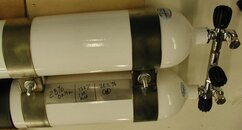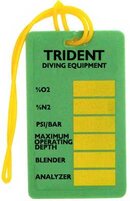About a month ago, this thread reminded me how dissatisfied I am with labeling cylinder contents. The old duct tape and Sharpie trick was never large enough when placed near the neck, accumulated goo, doesnt hold up all that well, and basically gets up my nose.
We were watching TV a few nights later while my wife was removing nail polish. She had these disposable gauze pads that she squired the remover on. That led me to wonder about just writing the content data on the stainless bands with a sharpie and erasing it with solvent. I liked it and here is what I have learned so far:
It would be even better if I had the stainless rolled before shearing something any HVAC/sheet metal shop can do. It would be best to roll it about 20% smaller in diameter than the cylinder so the edges stay down better. In an ideal world, electro-etched labels and boxes would be there for O2, N2, He, MOD, and analyzed O2 with date and initial.
Unfortunately, this isnt a viable solution for singles. Hopefully the collective imagination of Scubaboard can come up with improvements or even an entirely different way that works even better.
We were watching TV a few nights later while my wife was removing nail polish. She had these disposable gauze pads that she squired the remover on. That led me to wonder about just writing the content data on the stainless bands with a sharpie and erasing it with solvent. I liked it and here is what I have learned so far:
- Tons of solvents work, but the best for the money I have found is Lacquer Thinner.
- My wifes nail polish remover pads work great and I have a convenient supply!
- The handiest container Ive found so far is a flip-top lighter fluid can for cigarette lighters. Naphtha-based lighter fluid doesnt work as well as other solvents so make sure it has a cap that unscrews so you can refill it with something better.
- I had to be careful to write on areas of the bands that didnt get rubbed off in handling. It also was not as obvious as I would like
It would be even better if I had the stainless rolled before shearing something any HVAC/sheet metal shop can do. It would be best to roll it about 20% smaller in diameter than the cylinder so the edges stay down better. In an ideal world, electro-etched labels and boxes would be there for O2, N2, He, MOD, and analyzed O2 with date and initial.
Unfortunately, this isnt a viable solution for singles. Hopefully the collective imagination of Scubaboard can come up with improvements or even an entirely different way that works even better.






